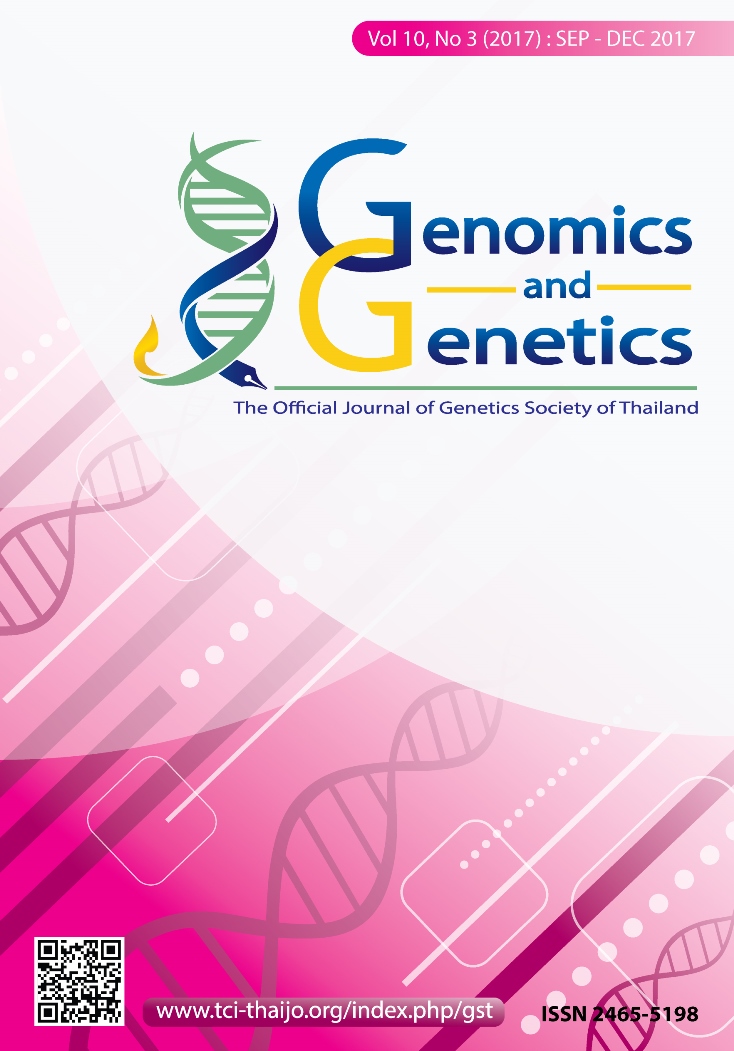Expression analysis and nucleotide variation of OsC1 gene associated with anthocyanin pigmentation in rice
DOI:
https://doi.org/10.14456/gag.2017.7Keywords:
OsC1 gen, Rice, Anthocyanins, Transcription factorAbstract
OsC1 gene encodes a R2R3-Myb transcription factor that regulates expression of structural genes in anthocyanins biosynthesis pathway in rice. Thus, the OsC1gene may play an important role for the coloration of rice pericarp. OsC1 gene expression in both leaf and seed tissues at different ages was examined in white, red and black rice. Expression of OsC1 gene was found in young leaf and seed tissues in all rice varieties in this study. In addition, black rice showed the highest expression level in seeds at 25 days after flowering, corresponded to dark purple (black) pericarp color. Comparisons of nucleotide sequences in exon 3 of OsC1 gene revealed 10-bp deletion in white and red rice, resulting in frameshift mutation in R3 region of Myb DNA binding domain. The result suggested that the OsC1 alleles of white and red rice were a loss-of-function mutation. The result from this study might be applied to rice improvement by developing molecular markers for selection of rice anthocyanin pigmentation.
References
Bagchi, D., Garg, A., Krohn, R., Bagchi, M., Bagchi, D., Balmoori, J., & Stohs, S. (1998). Protective effects of grape seed proanthocyanidins and selected antioxidants against TPA-induced hepatic and brain lipid peroxidation and DNA fragmentation, and peritoneal macrophage activation in mice. General Pharmacology: The Vascular System, 30(5), 771-776.
Chandler, V. L., Radicella, J. P., Robbins, T. P., Chen, J., & Turks, D. (1989). Two regulatory genes of the maize anthocyanin pathway are homologous: isolation of B utilizing R genomic sequences. The Plant Cell, 1(12), 1175-1183.
Chin, H.-s., Wu, Y.-p., Hour, A.-l., Hong, C.-y., & Lin, Y.-r. (2016). Genetic and Evolutionary Analysis of Purple Leaf Sheath in Rice. Rice, 9(1), 8.
Choudhury, B. I., Khan, M. L., & Dayanandan, S. (2014). Patterns of nucleotide diversity and phenotypes of two domestication related genes (OsC1 and Wx) in indigenous rice varieties in Northeast India. BMC genetics, 15(1), 71.
Cossins, E., Lee, R., & Packer, L. (1998). ESR studies of vitamin C regeneration, order of reactivity of natural source phytochemical preparations. IUBMB Life, 45(3), 583-597.
Furukawa, T., Maekawa, M., Oki, T., Suda, I., Iida, S., Shimada, H., Kadowaki, K. (2007). The Rc and Rd genes are involved in proanthocyanidin synthesis in rice pericarp. The Plant Journal, 49(1), 91-102.
Geekiyanage, H., Jicha, G. A., Nelson, P. T., & Chan, C. (2012). Blood serum miRNA: non-invasive biomarkers for Alzheimer's disease. Experimental neurology, 235(2), 491-496.
Hwang, S.-K., & Kim, Y.-M. (2000). A simple and reliable method for preparation of cross-contamination-free plant genomic DNA for PCR-based detection of transgenes. J Biochem Mol Biol, 33(33), 537-546.
Inta, P., Phongburaphat, W., Pongjareankit, S., Chowpongpang, S., Sangtong, V., & Sakulsingharoj, C. (2013).Cloning and Characterization of OSB2 Gene Controlling Anthocyanin Biosynthesis in Rice. Thai J. Genet, 6(1), 25-29.
Ithal, N., & Reddy, A. R. (2004). Rice flavonoid pathway genes, OsDfr and OsAns, are induced by dehydration, high salt and ABA, and contain stress responsive promoter elements that interact with the transcription activator, OsC1-MYB. Plant Science, 166(6), 1505-1513.
Koes, R., Verweij, W., & Quattrocchio, F. (2005). Flavonoids: a colorful model for the regulation and evolution of biochemical pathways. Trends in plant science, 10(5), 236-242.
Liu, Y., Lin-Wang, K., Deng, C., Warran, B., Wang, L., Yu, B., . . . Zhang, J. (2015). Comparative transcriptome analysis of white and purple potato to identify genes involved in anthocyanin biosynthesis. PloS one, 10(6), e0129148.
Martin, C., & Paz-Ares, J. (1997). MYB transcription factors in plants. Trends in Genetics, 13(2), 67-73.
Reddy, V., Dash, S., & Reddy, A. (1995). Anthocyanin pathway in rice (Oryza sativa L): identification of a mutant showing dominant inhibition of anthocyanins in leaf and accumulation of proanthocyanidins in pericarp. TAG Theoretical and Applied Genetics, 91(2), 301-312.
Reddy, V. S., Goud, K. V., Sharma, R., & Reddy, A. R. (1994). Ultraviolet-B-responsive anthocyanin production in a rice cultivar is associated with a specific phase of phenylalanine ammonia lyase biosynthesis. Plant physiology, 105(4), 1059-1066.
Saitoh, K., Onishi, K., Mikami, I., Thidar, K., & Sano, Y. (2004). Allelic diversification at the C (OsC1) locus of wild and cultivated rice. Genetics, 168(2), 997-1007.
Sakamoto, W., Ohmori, T., Kageyama, K., Miyazaki, C., Saito, A., Murata, M., . . . Maekawa, M. (2001). The Purple leaf (Pl) locus of rice: The Plw allele has a complex organization and includes two genes encoding basic helix-loop-helix proteins involved in anthocyanin biosynthesis. Plant and Cell Physiology, 42(9), 982-991.
Sakulsingharoj, C., Inta, P., Sukkasem, R., Pongjaroenkit, S., Chowpongpang, S., & Sangtong, V. (2015). Overexpression of OSB2 gene in transgenic rice up-regulated expression of structural genes in anthocyanin biosynthesis pathway. Genomics and Genetics, 7(3), 173-182.
Sakulsingharoj, C., Inta, P., Sukkasem, R., Pongjaroenkit, S., Chowpongpang, S., & Sangtong, V. (2016). Cloning and characterization of OSB1 gene controlling anthocyanin biosynthesis from Thai black rice. Genomics and Genetics, 9(1), 7-18.
Shi, J., Yu, J., Pohorly, J. E., & Kakuda, Y. (2003). Polyphenolics in grape seeds—biochemistry and functionality. Journal of medicinal food, 6(4), 291-299.
Shih, C. H., Chu, H., Tang, L. K., Sakamoto, W., Maekawa, M., Chu, I. K., . . . Lo, C. (2008). Functional characterization of key structural genes in rice flavonoid biosynthesis. Planta, 228(6), 1043-1054.
Sweeney, M. T., Thomson, M. J., Pfeil, B. E., & McCouch, S. (2006). Caught red-handed: Rc encodes a basic helix-loop-helix protein conditioning red pericarp in rice. The Plant Cell, 18(2), 283-294.


